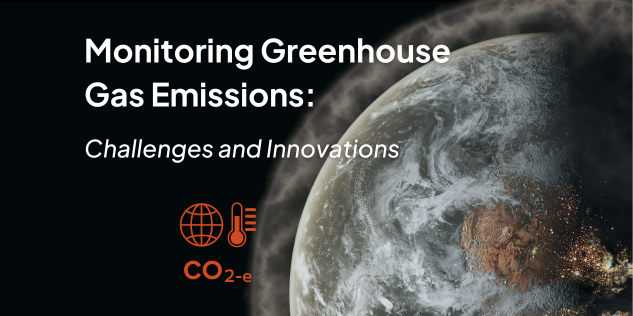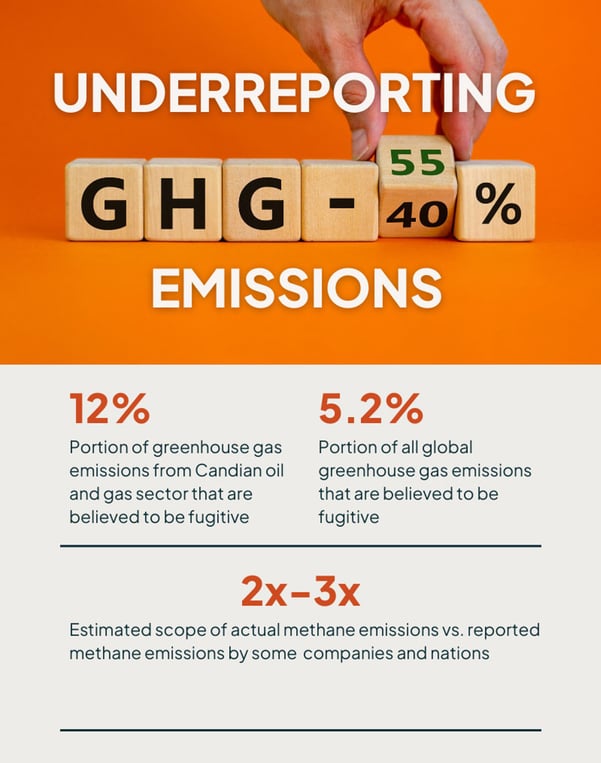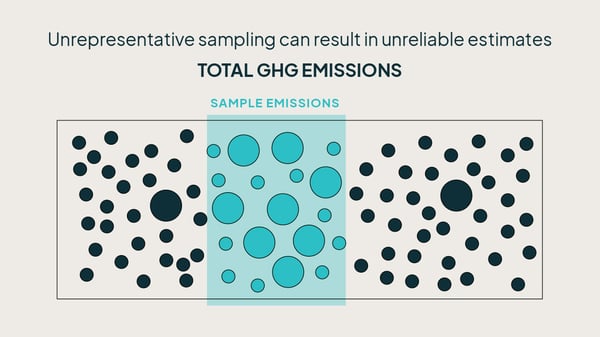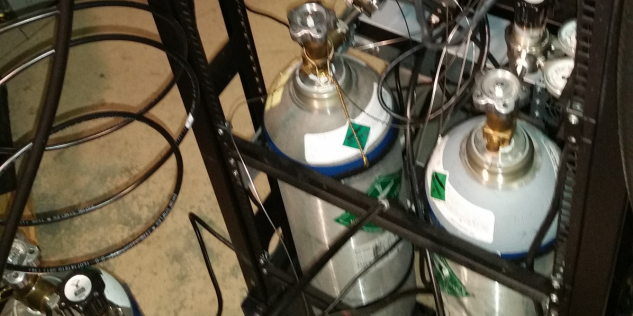
Climate change is an urgent global issue marked by increasingly severe weather, rising sea levels, droughts, flooding, and a rise in average global temperatures. To limit global warming to 1.5°C above pre-industrial levels, as outlined in the 2015 Paris Agreement, the world would need to cut greenhouse gas (GHG) emissions in half by 2030. This blog post delves into the challenges and potential solutions for effectively monitoring and reducing these emissions.
We'll cover:
- Why we need to cut GHG emissions
- Why effective monitoring is so important for managing GHGs
- Challenges for the bottom-up approach to GHG monitoring
- Challenges for the top-down approach to GHG monitoring
- How we’re overcoming GHG measurement challenges
- Where we go from here
Why we need to cut greenhouse gas emissions
With the ten warmest years on record all occurring since 2010, global temperatures are presently increasing at an accelerating rate. This point has been reinforced clearly in 2023 with the hottest June on record followed in July by the hottest week on record.
It all serves as a grim reminder that it will take dramatic action to limit warming to 1.5°C above pre-industrial levels -- the threshold set by the 2015 Paris Agreement. In fact, scientists estimate that the world will need to cut emissions of heat-trapping greenhouse gases (GHGs) in half by 2030 to avoid overshooting that target.
As a reminder, the threshold of 1.5°C was established by the Paris Agreement because it’s believed that limiting warming to 1.5° may avoid many (but not all) of the worst effects of climate change. Every tenth of a degree beyond that target carries increased risk and additional negative consequences.
Effective monitoring is key to managing greenhouse gases
To achieve dramatic reductions in GHG emissions, we must be able to accurately measure them. As the saying goes, if you can’t measure it, you can’t improve it.
That’s why the World Meteorological Organization (WMO) has called for sustained, coordinated global monitoring of GHG concentrations and fluctuations. According to a statement by the WMO issued in January 2023, such monitoring “is vital to help us understand and tackle the drivers of climate change and to support implementation of the Paris Agreement.”
Unfortunately, measuring GHG emissions is no easy task.
Challenges with bottom-up GHG monitoring
The method that many countries and companies have used to estimate their GHG emissions is the bottom-up approach.
At the risk of oversimplifying, the bottom-up approach begins with an inventory of GHG-emitting activities. For each activity, it looks at two key variables: (a) the rate at which the activity tends to produce GHG emissions and (b) the duration of the activity (how much it was performed). The combination of these two variables yields the total GHG emissions for each activity. When emissions from the various activities are compiled together, we get a seemingly complete inventory of total GHG emissions, thus building an overall profile from the bottom up.

Unfortunately, the bottom-up approach does a poor job of accounting for fugitive emissions. These are unexpected leaks and other irregular releases of GHGs from pressurized containment, such as appliances, storage tanks, wells, or pipelines. By definition, fugitive emissions are unexpected, making them inherently difficult to account for.
So, how significant are fugitive emissions? A study of oil and gas activities in Canada found that fugitive leaks accounted for about 12% of the entire sector’s GHG emissions in 2000. Another study estimated that fugitive emissions accounted for about 5.2% of world greenhouse emissions in 2013.
Even when companies or nations attempt to factor in the “typical” amount of leakage, scientists have found that they tend to vastly underestimate the problem. For example, studies involving direct atmospheric measurement have found that nations and companies are emitting double or triple as much methane as they are reporting.

Challenges with top-down GHG monitoring
The top-down approach begins with direct measurement of total atmospheric greenhouse gases within a region. It then works backwards to infer the sources and the extent of each source’s contribution.
Since the top-down approach directly measures atmospheric gas concentrations, its accuracy does not depend on uncovering fugitive emissions sources. In fact, discrepancies between top-down measurements and bottom-up estimates can be used to identify potential fugitive leaks.
However, the top-down approach is susceptible to a different set of problems. For example, it can be difficult to infer the contributions of individual sources from total GHG measurements. In addition, variations in pressure, temperature, and relative humidity can negatively impact the accuracy of top-down measurements when sensors are not calibrated for the conditions.
There is also the issue of sample bias. Top-down measurements taken at one time may or may not be representative of emissions occurring at other times. Measurements taken at one location may or may not be representative of emissions occurring at other locations in the area.

To illustrate how significant sample bias can be, one study found that top-down measurements of methane emissions in a natural gas production region were being collected each day specifically when emissions were peaking (due to scheduled venting of the natural gas wells). Emissions throughout the rest of the day were lower. The authors concluded the sample bias associated with these unrepresentative samples was large enough to account for differences in top-down and bottom-up estimates of methane emissions.
How we’re overcoming GHG measurement challenges
AEM has partnered with the National Institute of Standards and Technology (NIST) to develop a greenhouse gas observation network that overcomes many of the measurement challenges. The network is comprised of nearly 50 nodes and still growing.
In case you aren’t familiar with the NIST, it was established by Congress in 1902 to advance measurement science, standards, and technology in ways that enhance economic security and improve quality of life. One of its current initiatives is to develop tools and standards to accurately measure greenhouse gas emissions, so industries and governments can manage them more effectively.
The network that we operate on behalf of the NIST avoids problems with fugitive emissions by utilizing a top-down approach. Yet, it also avoids many of the problems commonly associated with top-down measurements. For example:
- To mitigate sample bias that can arise from taking measurements at a specific point in time, our GHG sensors take continuous measurements while reporting results at intervals of 1 minute, 5 minutes, and 20 minutes.
- To minimize sample bias that can arise from taking measurements at only one elevation, we take measurements at multiple heights ranging from 50 to 300 meters.
- To help ensure that sensor accuracy is not adversely affected by variable humidity and moisture, air is dried before reaching the sensors.
- To ensure that other variable weather conditions do not interfere with the accuracy of measurements, each sensor is outfitted with calibration tanks that contain known concentrations of GHG gases. The tanks are from NOAA and meet or exceed World Meteorological Organization (WMO) calibration standards.
NOAA calibration tanks installed at a GHG observation site. 
-
To better understand the influence of variable weather conditions (such as wind, humidity, air pressure, etc.) on fluctuating GHG concentrations, each sensor is co-located with one of AEM’s Davis Instruments weather stations. This information assists investigators in determining the trajectories and sources of GHG fluctuations.
Davis Instruments weather station installed at a GHG observation site. 
Where do we go from here?
Our ability to accurately monitor GHG emissions is a critical component of the battle against climate change. While both bottom-up and top-down approaches have their challenges, innovative partnerships like the one between AEM and NIST are paving the way for more precise and reliable measurements. By continuing to improve our monitoring capabilities and understanding the complexities of GHG emissions, we can better manage and reduce our impact on the environment.
To better understand what all this may mean for your business or community, contact us for a free consultation with one of our environmental monitoring experts.
*Special thanks to my colleague, Dr. Elizabeth DiGangi, who serves as both a lightning scientist and GHG data quality specialist at AEM. Dr. DiGangi plays a key role in monitoring greenhouse gas data on a daily basis to help ensure its quality and integrity. She also provided critical input to support the development of this article.